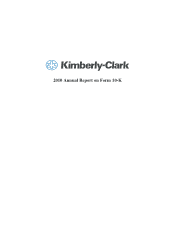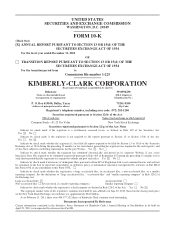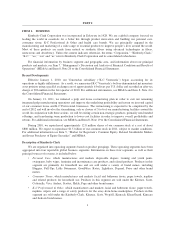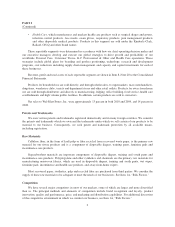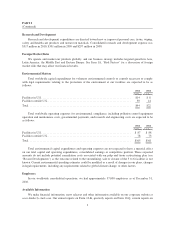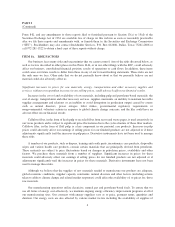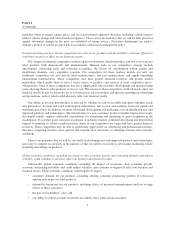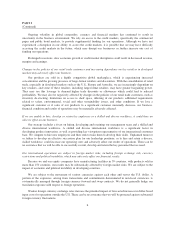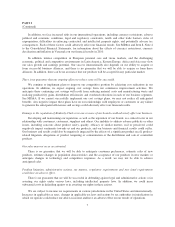Kimberly-Clark 2010 Annual Report Download - page 10
Download and view the complete annual report
Please find page 10 of the 2010 Kimberly-Clark annual report below. You can navigate through the pages in the report by either clicking on the pages listed below, or by using the keyword search tool below to find specific information within the annual report.
PART I
(Continued)
Ongoing volatility in global commodity, currency and financial markets has continued to result in
uncertainty in the business environment. We rely on access to the credit markets, specifically the commercial
paper and public bond markets, to provide supplemental funding for our operations. Although we have not
experienced a disruption in our ability to access the credit markets, it is possible that we may have difficulty
accessing the credit markets in the future, which may disrupt our businesses or further increase our cost of
funding our operations.
Prolonged recessions, slow economic growth or credit market disruptions could result in decreased revenue,
margins and earnings.
Changes in the policies of our retail trade customers and increasing dependence on key retailers in developed
markets may adversely affect our business.
Our products are sold in a highly competitive global marketplace, which is experiencing increased
concentration and the growing presence of large-format retailers and discounters. With the consolidation of retail
trade, especially in developed markets such as the U.S., Europe and Australia, we are increasingly dependent on
key retailers, and some of these retailers, including large-format retailers, may have greater bargaining power.
They may use this leverage to demand higher trade discounts or allowances which could lead to reduced
profitability. We may also be negatively affected by changes in the policies of our retail trade customers, such as
inventory de-stocking, limitations on access to shelf space, delisting of our products, additional requirements
related to safety, environmental, social and other sustainability issues, and other conditions. If we lose a
significant customer or if sales of our products to a significant customer materially decrease, our business,
financial condition and results of operations may be materially adversely affected.
If we are unable to hire, develop or retain key employees or a skilled and diverse workforce, it could have an
adverse effect on our business.
Our strategy includes a focus on hiring, developing and retaining our management team and a skilled and
diverse international workforce. A skilled and diverse international workforce is a significant factor in
developing product innovation, as well as providing key viewpoints representative of our international consumer
base. We compete to hire new employees and then seek to train them to develop their skills. Unplanned turnover
or failure to develop an effective succession plan for our leadership positions, or to hire and retain a diverse,
skilled workforce, could increase our operating costs and adversely affect our results of operations. There can be
no assurance that we will be able to successfully recruit, develop and retain the key personnel that we need.
Our international operations are subject to foreign market risks, including foreign exchange risk, currency
restrictions and political instability, which may adversely affect our financial results.
Because we and our equity companies have manufacturing facilities in 39 countries, with products sold in
more than 150 countries, our results may be substantially affected by foreign market risks. We are subject to the
impact of economic and political instability in developing countries.
We are subject to the movement of various currencies against each other and versus the U.S. dollar. A
portion of the exposures, arising from transactions and commitments denominated in non-local currencies, is
systematically managed through foreign currency forward and swap contracts. We do not generally hedge our
translation exposure with respect to foreign operations.
Weaker foreign currency exchange rates increase the potential impact of forecasted increases in dollar-based
input costs for operations outside the U.S. There can be no assurance that we will be protected against substantial
foreign currency fluctuations.
6

